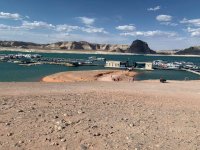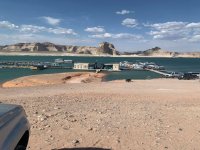Let's do some math, shall we?
You're leaving out of Wahweap Marina, via the Maytag Straits, past Padre Bay (to avoid the yahoos), to somewhere around Face Canyon (buoy 25), Last Chance Bay (buoy 28), or West Canyon (let's call it the same distance as buoy 30).
Using Last Chance as a theoretical destination, that's about 32 miles uplake from the Wahweap Rental dock. Please note, Last Chance is a very long bay, and the figure used only gets you to the mouth of Last Chance. At 8 mph, that's a 4 hour cruise. There are Wakeless Zones at Anchovy Point leaving Wahweap Bay, and at Antelope Point Marina, which you have to pass through, but we'll simplify our calculations and leave out the reduced fuel consumption and extra time in those areas. The specs on that boat say it burns 16 gallons per hour while underway. That figure is for BOTH motors, NOT for EACH motor. So 4 hours multiplied by 16 gallons per hour equal 64 gallons to arrive at the mouth of Last Chance. You will consume the same amount of gas covering the same distance on your return, so 128 gallons burned in transit, both ways.
Starting out with 300 gallons in the main tank, subtracting 128 gallons allocated to the outboards for travelling, you are left with 172 gallons to burn in your generator. Doing all your High Electrical Demand activities like showers, cooking, and using the A/C simultaneously, that 20 KW generator is going to burn 4 gallons per hour. 172 gallons left in your main tank, divided by 4 gallons per hour, left you enough gas to run the generator for 43 hours. On a 7 day trip, that allows for 6 hours of generator use each day. Let's hope it's not 110 degrees outside.
If you have a runabout or PWCs, the toy tank is going to be used keeping those fueled up. If you don't have anything to fuel up out of the toy tank, and you can pump that off into the main tank, that extra 100 gallons will allow you to run that generator an extra 25 hours, so 43 plus 25 give you a total of 68 hours of generator run time, which, when spread over a 7 day trip gives you the ability to run the generator for almost 10 hours per day. Better, but that still means taking care to get the most efficient use of the generator run time.
As others have stated the specs are quoting a really heavy fuel consumption rate for the outboards, but it is probably done to make sure you don't cut your fuel usage calculations too close.
So, in summary, back off the throttles, to maybe 6 mph, and stretch out the cruising fuel. Allow that extra fuel for driving around to find a beach and maneuvering into your camp once you find it. These numbers leave you arriving back a Wahweap on vapors, so you must never let that generator run if it is not ABSOLUTELY NECESSARY. Your vacation might be unpleasantly warm at times, but the alternative is running out of fuel and having to pay the rental office to send a rescue boat to do an emergency refuel. There's one word for that: EXPENSIVE. As if $5.03 for regular at Wahweap isn't bad enough! And, do yourself a favor: Make sure that the gas tanks are both ACTUALLY full BEFORE you depart. If you leave with anything less than 100% of the fuel you're supposed to have, all these calculations go out the window.
Take care, watch for whales, and enjoy the lake. I did 2 rentals before I bought into my own houseboat 15 years ago. Beware, you might find that this trip is the start of a regular habit.


